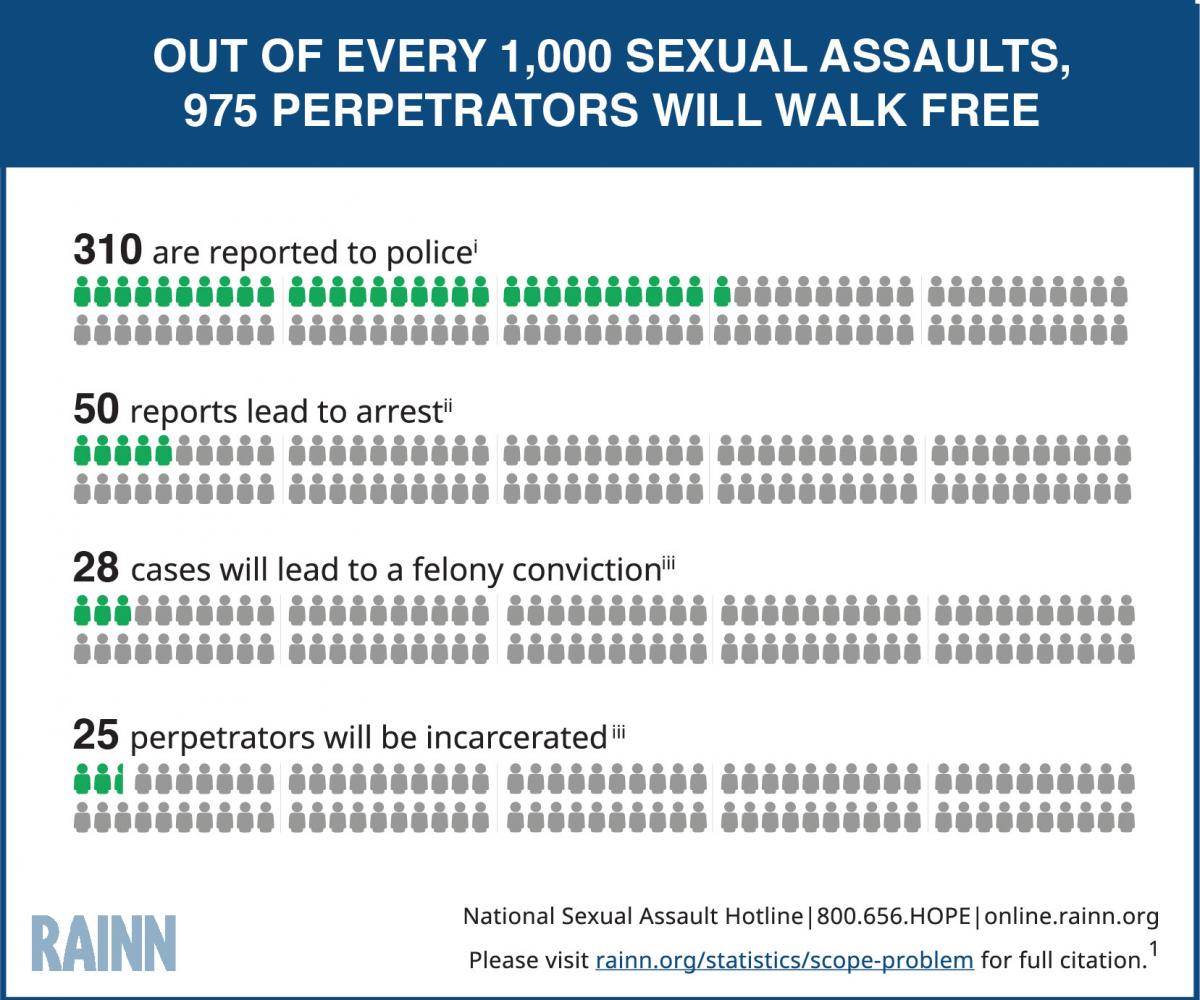The Criminal Justice System: Statistics
 995 perpetrators will walk free. Out of every 1,000 rapes, 310 are reported to the police, 57 reports lead to arrest, 13 cases get referred to prosecutors, 7 cases will lead to a felony conviction, 6 rapists will be incarcerated." width="1200" height="1185" />
995 perpetrators will walk free. Out of every 1,000 rapes, 310 are reported to the police, 57 reports lead to arrest, 13 cases get referred to prosecutors, 7 cases will lead to a felony conviction, 6 rapists will be incarcerated." width="1200" height="1185" />
Sexual violence is notoriously difficult to measure, and there is no single source of data that provides a complete picture of the crime. On RAINN’s website, we have tried to select the most reliable source of statistics for each topic. The primary data source we use is the National Crime Victimization Survey (NCVS), which is an annual study conducted by the Justice Department. To conduct NCVS, researchers interview tens of thousands of Americans each year to learn about crimes that they’ve experienced. Based on those interviews, the study provides estimates of the total number of crimes, including those that were not reported to police. While NCVS has a number of limitations (most importantly, children under age 12 are not included), overall, it is the most reliable source of crime statistics in the U.S.
We have also relied on other Justice Department studies, as well as data from the Department of Health and Human Services and other government and academic sources. When assembling these statistics, we have generally retained the wording used by the authors. Statistics are presented for educational purposes only. Each statistic includes a footnote citation for the original source, where you can find information about the methodology and a definition of terms.
Sources:
- i. Department of Justice, Office of Justice Programs, Bureau of Justice Statistics, National Crime Victimization Survey, 2015-2019 (2020). ii. Federal Bureau of Investigation, National Incident-Based Reporting System, 2012-2016 (2017); iii. Federal Bureau of Investigation, National Incident-Based Reporting System, 2012-2016 (2017); iv. Department of Justice, Office of Justice Programs, Bureau of Justice Statistics, Felony Defendants in Large Urban Counties, 2009 (2013). (This statistic combines information from several federal government reports. Because it combines data from studies with different methodologies, it is an approximation, not a scientific estimate. Please see the original sources for more detailed information. These statistics are updated annually and as new information is published.)
- Department of Justice, Office of Justice Programs, Bureau of Justice Statistics, Rape and Sexual Victimization Among College-Aged Females, 1995-2013 (2014).
- Department of Justice, Office of Justice Programs, Bureau of Justice Statistics, Crimes Against the Elderly, 2003-2013 (2014).
- Department of Defense, Fiscal Year 2014 Annual Report on Sexual Assault in the Military (2015).
- Department of Justice, Office of Justice Programs, Bureau of Justice Statistics, Female Victims of Sexual Violence, 1994-2010 (2013).
- Department of Justice, Office of Justice Programs, Bureau of Justice Statistics, Felony Defendants in Large Urban Counties, 2009 (2013).
- Department of Justice, Office of Justice Programs, Bureau of Justice Statistics, Prisoners in 2013 (2014).

 995 perpetrators will walk free. Out of every 1,000 rapes, 310 are reported to the police, 57 reports lead to arrest, 13 cases get referred to prosecutors, 7 cases will lead to a felony conviction, 6 rapists will be incarcerated." width="1200" height="1185" />
995 perpetrators will walk free. Out of every 1,000 rapes, 310 are reported to the police, 57 reports lead to arrest, 13 cases get referred to prosecutors, 7 cases will lead to a felony conviction, 6 rapists will be incarcerated." width="1200" height="1185" />